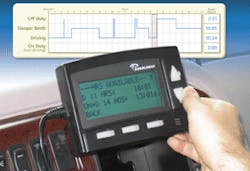The Federal Motor Carrier Safety Administration’s (FMCSA) goal to issue an electronic on-board recorder (EOBR) rulemaking in the first-quarter—whether it makes the device mandatory or not— brings to question the driver productivity benefits of paperless logs.
Industry experts say that EOBR technology, aside from automating logbooks, could be easily piggybacked with other service suites that boost utilization and safety. And that is perhaps the reason why EOBRs have gained widespread acceptance among private fleets.
“Most of our carriers have EOBRs,” Bob Inderbitzen, National Private Truck Council director of safety & compliance told FleetOwner, noting that some of its members leverage asset tracking and communications capabilities on the same platform. “They have the ability to know where their equipment is all the time and also monitor performance.”
Brian McLaughlin, marketing vp for PeopleNet told FleetOwner that PeopleNet’s system with integrated electronic log features yield direct benefits to the driver, such as time savings of 20 minutes per day, automated log book entries, human error reduction, and eliminating the need to record odometer readings. An in-cab monitor issues drivers alerts when potential hours-of-service (HOS) violations are detected, as well as displays remaining time.
Fleet management could also use the system to quickly assess how much on-duty time each of their drivers have remaining to better plan routes, McLaughlin added.
Although the safety benefits of the technology are difficult to quantify, carriers have expressed confidence that it makes a positive impact. For example, in-vehicle sensors can track driving behavior and discourage excessive speed, which also would give a side benefit of fuel savings. And because vehicle sensors also ensure accurate records of on-duty time, the likelihood of drivers conforming to their allotted hours-of-service, thus decreasing the likelihood of fatigue, is increased.
Inefficient driving behavior such as hard braking could also be tracked on many systems, bolstering effectiveness as a management tool.
“Very few of our customers just use it use our system for electronic logging alone,” McLaughlin said. “Many of our clients buy it for multiple features…such as for accident reconstruction, communications, driver management, driver performance monitoring, making sure they’re not driving too fast or idling too much. It could can drive payroll systems.”
Qualcomm also offers an electronic logging solution in its OmniTRACS platform. For example, data from this performance monitoring solution can be leveraged to a HOS EOBR Application.
Qualcomm has also designed the HOS application to be a management tool by providing accurate, up-to-date driver availability information to assist with load planning via a Web interface.
For more information, go to www.peoplenetonline.com/ProductsServices.aspx?id=61 or www.qualcomm.com/qwbs/solutions/prodserv/omnitracs.shtml.
